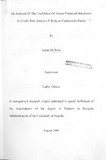| dc.description.abstract | The management of risk is key to the success of any organization. In
the financial sector the most significant risk is credit risk. The import
of credit risk can be seen from the fact that the primary reason a bank
fails or falls into big trouble are bad loans or too many other bad debts
(Nickson, 2002). The Kenyan banking sector, in particular, has been
ailed over the years by the relatively high level of non-performing
loans i.e. 30 percent of its total loans have been non-performing as at
30-12-2001 (CBK).
Information is a crucial ingredient in the management of risk.
According to Berry et ai., 1993 and Danes et ai., 1989 financial
information is the most valuable information in the bank lending
decision. Financial reports and statements about a company are a key
source of information in a assessing its financial condition (Coyle,
2000). Yet according to Jarvis et ai, 1996 very little is known as to
how users of corporate financial reports use the information contained
in these reports.
The study consequently had three objectives; to establish whether
credit risk analysts in Kenyan commercial banks use financial
statements in credit risk assessment, to identify the sections of annual
(iv) UNIVERSITY OF NAIROBI
L.OWER KABETE CAMPUS
reports which credit risk analysts find most useful and to find out from
credit risk analysts in Kenyan commercial banks improvements that can
be made to financial statements.
All the commercial banks operating in Kenya were sampled and asked
to provide information through the use of questionnaire. The
respondents for the study were the credit risk analysts of the banks.
The study revealed that cred it risk analysts use information derived
from financial statements in their lending decisions. The study showed
that credit risk analysts do not rely on only one source of information.
Credit risk analysts also indicated that they would like some
improvements made to annual reports.
These results are expected to be useful both for organizations seeking
loan finance and for accounting standards setters. They are also useful
as a reference point for comparative studies that might be undertaken
in other African countries. | en |

